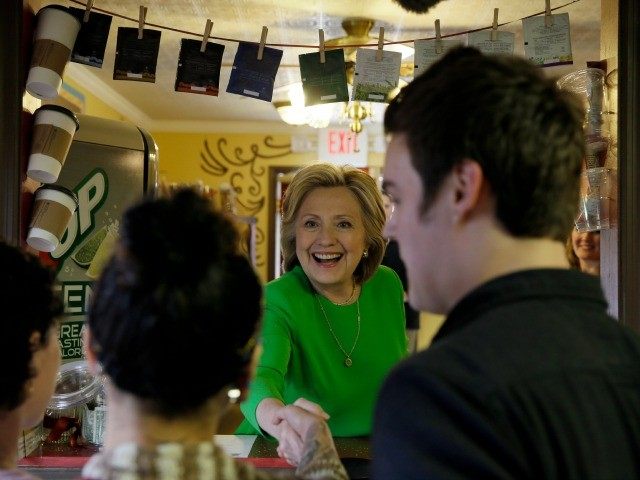On Tuesday, USA Today put together a comparison between the social media footprints of the declared presidential candidates – Senators Ted Cruz, Rand Paul, and Marco Rubio on the Republican side, plus Hillary Clinton for the Democrats. For some reason, they chose to headline and introduce the piece with Rubio’s comparatively disappointing performance – “Rubio Launch Lags Behind Competitors On Social Media” – even though it’s really about all of them, and the most important takeaway is that Clinton’s announcement “generated more social media traffic that all her Republican competitors combined.”
Like all efforts to measure true popularity and influence using Internet hits, it’s interesting and relevant, because we live in the social media era, but such popularity is also fickle and easily faked. It seems like most politicians have tumbled to the idea of building up “Astroturf” political support, so they can brag about impressive numbers of Twitter followers and Facebook friends.
Sometimes they purchase blocs of phony followers outright; other times, their supporters cheerfully provide Astroturf for them. Manufactured approval isn’t limited to politics, either – there are plenty of sources out there who will sell you a pile of made-to-order five-star reviews to make your book, music, or other products look popular on consumer websites.
Online approval is not difficult to manufacture. With a little tech savvy, the Internet becomes a lens that can magnify a small group of people into what seems like a significant grassroots movement. Radio host Rush Limbaugh mentioned yesterday that most of the alleged “Internet campaign” to pressure advertisers to back out of his show in 2012 was the work of just ten people, using programs that allowed them to produce blizzards of Twitter messages and email.
Limbaugh mentioned this while bringing up a UK Daily Mail story, largely unreported by American media, that a huge volume of Hillary Clinton’s Twitter and Facebook support comes from fake accounts. Some 2 million of her 3.6 million Twitter “followers” are non-responsive accounts that apparently exist only to plump up Clinton’s social media profile, and over 544,000 of them are clearly fake. Plus, 46,000 of her Facebook “likes” turned out to be coming from Baghdad, Iraq.
The Daily Mail recalled that Clinton’s State Department got busted for blowing $630,000 in taxpayer money on purchasing phony Facebook friends to make itself look popular. It seems very disingenuous to run a story about Clinton’s ostensible Internet popularity without mentioning any of this.
Measuring popularity with Internet stats is an uncertain science at best, even when the raw data is verified. With that in mind, USA Today relates a Facebook report that 695,000 users generated 1.3 million interactions – including “likes,” posts, comments on posts, and link shares – related to Rubio’s announcement on Monday, compared to 865,000 people producing 1.9 million interactions about Rand Paul, 2.1 million people producing 5.5 million interactions about Ted Cruz, and 4.7 million people producing 10.1 million interactions for Hillary Clinton on their first days. (The USA Today post has a typo that says Hillary’s 10.1 million interactions came from “4.7 people.”
Or maybe her Astroturf operation is even more powerful than the Daily Mail thought…!) There’s also a comparison between re-Tweets of the candidates’ announcement messages on Twitter: 2,500 for Rubio, 2,300 for Paul, 13,000 for Cruz, and 100,000 for Clinton.
There are all sorts of problems with analysis based on these metrics, beginning with the obvious matter of whether those comments, links, and re-Tweets connote approval. The total buzz level is interesting – an ignored campaign launch is probably worse than one attracting a great deal of negative attention, because the most important thing on Day One is to get noticed – but other than Facebook “likes,” it’s tough to separate positive and negative online chatter, or real people talking from bot-generated traffic mirages.
When someone creates an algorithm that can weed out sarcasm – the stalwart conservative who says “I love Hillary!”, or the liberal activist who declares “Ted Cruz would make a GREAT president!”, as an ironic joke to their friends – then artificial intelligence will have truly arrived.
It’s also difficult to extrapolate real-world influence from flashes of online popularity, especially since the latter is so easy and ephemeral. Look at how easy it is for disapproving clicks to snowball into online hate mobs that get people fired from their jobs, or threaten the existence of targeted businesses. Single-click passion is the most fickle force ever unleashed upon the public imagination. It takes no effort whatsoever to express what is widely interpreted as strong support or disapproval… and no effort to take it back later.
An awful lot of voters who will count on Election Day aren’t inclined to spend time creating social media posts about candidate announcements today. Polling is all about extrapolating samples to larger populations, but it’s impossible to make reliable extrapolations from Internet traffic to the general public, even with the incredible growth of social media over the past few years.
It’s probably safe to conclude that Clinton’s announcement generated more real online activity than Cruz, Paul, or Rubio, and Paul’s buzz level seems disappointing given the youthful demographic he’s reaching out to, and the level of emphasis he places on issues of digital privacy. Cruz has been popular online for a long time, so it’s not too surprising he did better than the other declared Republicans to date. Name recognition counts for a lot in the very early days of the long primary season, and Clinton unsurprisingly has more of it than the three Republican senators. Analysis deeper than that is like trying to draw a map of the clouds.

COMMENTS
Please let us know if you're having issues with commenting.